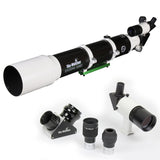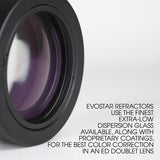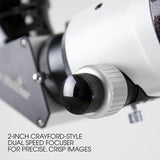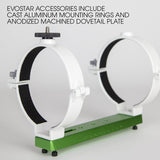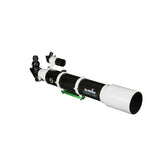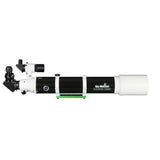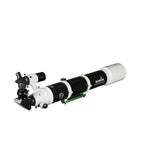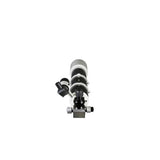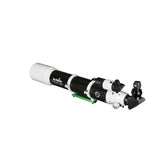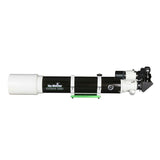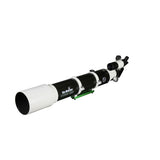Yes, our inventory is accurate!
![]() Qualifies for Free Ground Economy Shipping (CONUS Only)
Qualifies for Free Ground Economy Shipping (CONUS Only)
- 120 mm apochromatic Refractor with Schott BK-7 and FPL-53 ED glass
- 900 mm focal length (f/7.5)
- Dual-speed 2″ Crayford-type focuser with 1.25″ adaptor
- 8×50 RA erect-image finderscope
- 2″ dielectric diagonal
- 20 mm and 5 mm 1.25″ eyepieces
- Tube-ring attachment hardware
- Aluminum carry case
SKY-WATCHER EvoStar 120ED APO REFRACTOR: Serious Amateurs will Love the SW 120mm ED-APO Refractor
Sky-Watcher high-performance ED-APO refractors offer premium optical performance for the discriminating amateur astronomer. Refractors are coveted for their superb contrast, high-definition and coal-black sky background that make stars appear like diamonds embedded in black velvet. SW APO refractors utilize the most modern optical glasses and fabricating techniques to deliver the ultimate in high-fidelity astronomical imaging. Subtle details pop as never seen before in telescopes of lesser optical capability.
Observing with the Sky-Watcher EvoStar 120ED APO Refractor
The additional aperture compared to a 100 mm diameter lens provides a dramatic increase in resolution and a heighten sense of seeing lunar and planetary surface phenomenon in seemingly 3D high-definition.
Touring the Moon…the rugged Southern Highlands of the lunar surface are rich in craters. To the southeast, the famous crater Theophilus is 65 miles across. The raised triple-peaked central area is striking to observe in your SW 120ED. The crater has massive walls and the basin is 14,000 feet deep. One of the southernmost craters, Clavius, is a very large crater 145 miles across. It is located south of Tycho. In this same area can be found craters Maginus and Longomotanus which are also very worthy of exploration. To the north, the young crater Tycho dominates the southern lunar landscape. Named after the famous Danish astronomer Tycho Brahe, it is a spectacular sight with very high-rimmed walls. Your SW120ED will provide an impressive view. North of Tycho appearing brightly in a basin is the famous Rupes Recta (the Straight Wall), an 800 foot mountain that is a “must see” for amateur astronomers. Your SW 120ED will show it clearly and sharply the way you want to see it. On the north end of Mare Nubium, almost on the lunar N-S and E-W center line can be found 3 craters grouped together: Arzachel a young impact crater 60 miles across and 13,000 feet deep shows a terraced structure and a system of channel-like narrow depressions in its basin called “rilles”. Nearby are Alphonsus, a 70 mile wide crater, and Ptolemaus a prominent ancient crater 90 miles across with a heavily worn dark interior. The Earth’s Moon offers a treasure trove of fascinating detail to explore with your SW 120ED-APO EQ5 PRO. We have only featured a relative few examples of what is available. The views you will experience are so clear and sharp it might just feel like a veritable space-walk.
Planets are spectacular…the inner solar-system presents the colorful rusty-red planet Mars. Mars is a challenge for amateur astronomers, but your SW 120ED will show some very interesting detail. Olympus Mons, a volcanic crater 375-miles across and 16-miles high, is just one of the quests your capable SW120ED can tackle. Nirgal Vallis is a channel 600 miles long that responds well to the razor sharp contrast provided by the SW 120ED. The Grand Canyon of Mars, Valles Mariners, dwarfs that of our Earth’s Grand Canyon, but it still requires superb optics to view even though it is 150 miles wide and 4 miles deep. When prominent, the gleaming white Mars’ polar cap is in stark contrast to the redish-orange surface landscape of the rest of the planet. The SW 120ED will show you this detail like you want to see it. The gas giant Jupiter displays its swirling equatorial bands in high-definition with festoons and tonality within the bands. With regular observation, you will be able to follow storms and disturbances cross the planet in the southern equatorial band. Saturn’s storied surface phenomenon is simply stunning. View the rings and clearly see Cassini’s Division and cloud belts across its equator.
View Wonders of Deep-Space…beyond the solar-system hunt down double stars like Epsilon Lyrae, and the “double-double” in Lyra. A 120 mm ED-APO refractor will provide a crisp well defined image on par with up to a 7″ reflector. Always a star-party favorite, the beautiful double Alberio located in the tail of Cygnus is sensational. Alberio appears like a gold sparkler and its companion looks like a blue-green sparkler. It is a perfect object to view with your SW 120ED. Algol, an eclipsing variable star, sometimes called the “winking eye” fluctuates in brightness and is a suitable subject for the SW 120ED. Aldebaran, a beautiful orange giant in the Constellation Taurus is a delightful sight to view with the SW 120ED. In the eastern corner of Constellation Orion, Rigel, a bright blue double has a blue-green companion that requires excellent optics to see, a worthy subject for the SW 120ED. Tight globular star clusters like M13 in the Constellation Hercules appear like a beehive of crisp stellar pin points circling the central core, star upon thousands of stars. Compact globular star clusters lend themselves well to a refractor. M5 is a worthy object for viewing. M92, in the Constellation Hercules, is very compact globular with a bright core. It is a great object to view with the SW 120ED. M4, M10 and many other globular clusters can be seen well with the SW 120ED-APO refractor. The bright central cores of prominent nebulae can be seen and the brightest stars can be observed illuminating the glowing nebulosity which appears as ghostly apparitions.
The superb capabilities of the SW 120ED provide performance on a par with a reflector of perhaps up to 7″ in diameter on lunar, planetary, double-stars, globular star clusters, and depending on your ranking of unobstructed high-contrast as a necessary attribute, even the brighter nebulae may look better to you in a SW 120ED. These objects will stand out in bold relief contrasted against a very dark velvet-black sky background. Many advanced amateur astronomers feel the ED-APO experience is astronomy’s richest.
As an astrograph, the SW EvoStar 120ED APO performs superbly delivering crisp, high-fidelity imaging of planetary, lunar and aperture appropriate deep-space phenomenon.
Refractors – the Ultimate Imaging Instruments
In a given aperture size, refractors will always exhibit sharper images than other optical designs because the refractor concentrates more light into the central airy-disk and first diffraction rings. There is no diffraction pattern interference caused by a diagonal mirror or secondary mirror being suspended in the optical path (central obstruction) as is the case with reflectors.
Included Components for Selected Models
All Sky-Watcher USA EvoStars come with 2-speed backlash-free 2” Crayford-style focusers and quality foam-lined metal carrying cases as standard equipment. EvoStars are also supplied with right-angle 8x50mm viewfinder with bracket; 2” dielectric diagonal; two 1.25” LE (Long Eye relief) eyepieces (LET20mm and LET5mm); 1.25” focuser adaptor; and tube ring attachment hardware that works with compatible mounts.
| Optical Info | |
|---|---|
| Optical Design | ED Doublet |
| Lens Coatings | Fully Multi-Coated |
| Glass Type | BK7/FPL-53(ED) |
| True Aperture (mm) | 120.5 |
| Primary Aperture (mm) | 120 |
| F/Ratio | 7.5 |
| Focal Length (mm) | 900 |
| Observational Info | |
| Dawes Limit | 0.97 |
| Rayleigh Limit | 1.16 |
| Limiting Mag. | 12.9 |
| Minimum Magnification | 17 |
| Maximum Magnification | 236 |
| Light Gathering (compared to next size down) | 44% |
| General Info | |
| Focuser | 2" Dual Speed Crayford |
| OTA Length (Retract/Ext.) | 36" |
| OTA Outer Diameter | 5.625" |
| OTA Weight (with accessories) | 13.9 |
| Accessories | |
| Included Finder | 8x50 RACI |
| Included Diagonal | 2" Dielectric |
| Mounting Accessories | Rings/V-Rail |
| Included Eyepieces | 25mm LET/5 Planetary |
| Magnification w/ Included Eyepieces | 45x/180x |
| Included Case | Yes |
| Corrector | No (optional) |


